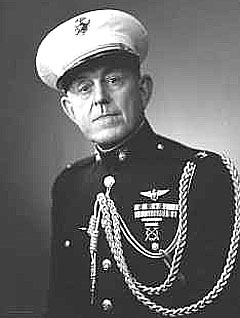SMITH-BERNARD
BERNARD LEWIS "BARNEY" SMITH

COL

PIONEER MARINE CORPS AVIATOR
Bernard Lewis Smith was born in Richmond, Virginia, on June 19, 1886. After studying Engineering at Virginia Polytechnic Institute, he enrolled as a Second Lieutenant in the Marine Corps Reserve in 1909. After attending the Marine Officer School, he was stationed aboard the battleship USS Louisiana (BB-19). In September 1912, he reported to Naval Aviation Camp at Annapolis, Maryland, for aviation instruction. This date determined his precedence as Naval Aviator #6 and Marine Corps Aviator #2. He received a Seaplane Certificate in 1913 and Pilot Certificate in 1914. After a period as a test pilot among other duties, he was assigned in 1914 to the U.S. Embassy in Paris, visiting French aerial units and making flights over German lines during the early months of World War One. At his recommendation, the U.S. Navy created a school for aerial gunnery and bombing in Miami. During the war, Smith had a variety of duty assignment in the United States and Paris. After the war he continued to have a variety of assignment in the United States which included the October 1918 flight delivery of Navy dirigible C-1 from Akron, Ohio, to Rockaway, New York. Another notable assignment was as a member of the planning, construction, and support crew for the Navy-Curtiss (NC) flying boats which culminated in 1919 with the successful flight of NC-4, the first airplane to make a transatlantic flight. In January 1920, Smith resigned his Marine Corps commission with the rank of Captain.
In 1921, Smith reportedly became Superintendent and Chief Engineer of Aeromarine Airways at Key West. Smith later rejoined the Marine Corps Reserve in 1937 with the rank of Major. He became an advisor to the Marine Corps Commandant in establishing a Marine Corps barrage balloon program and was responsible for the training of the barrage balloon personnel. From 1943 to 1945, he was the Naval Attaché for Air at several U.S. legations in Central American nations. His last active duty assignment is believed to have been as the Air Base Commander at Yokosuka, Japan, from which he retired from the Marine Corps in April 1946 with the rank of Colonel.
On February 2, 1947, COL Smith was driving alone at night to a relative’s home in Coral Gables, Florida. While driving, his car collided with a train and he was killed. The car’s windows were rolled up at the time of the collision and it has been speculated that he neither saw nor heard the train because if was raining. He is buried at Woodland Park Cemetery in Miami, Florida.
Submitted by CDR Roy A. Mosteller, USNR (Ret)

